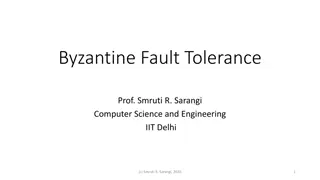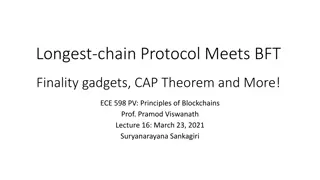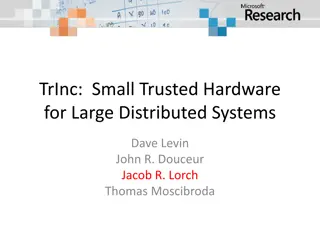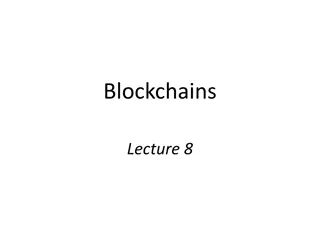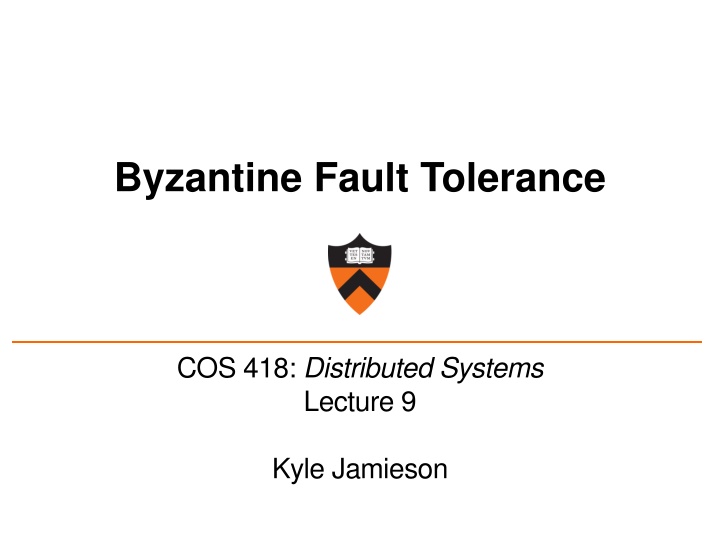
Byzantine Fault Tolerance in Distributed Systems Lecture
Explore Byzantine fault tolerance, state machine replication, and practical algorithms like Paxos and Raft in distributed systems. Learn about handling arbitrary failures, providing high reliability, and case studies on fault-tolerant systems like Boeing 777 fly-by-wire controls.
Download Presentation

Please find below an Image/Link to download the presentation.
The content on the website is provided AS IS for your information and personal use only. It may not be sold, licensed, or shared on other websites without obtaining consent from the author. If you encounter any issues during the download, it is possible that the publisher has removed the file from their server.
You are allowed to download the files provided on this website for personal or commercial use, subject to the condition that they are used lawfully. All files are the property of their respective owners.
The content on the website is provided AS IS for your information and personal use only. It may not be sold, licensed, or shared on other websites without obtaining consent from the author.
E N D
Presentation Transcript
Byzantine Fault Tolerance COS 418: Distributed Systems Lecture 9 Kyle Jamieson
So far: Fail-stop failures Traditional state machine replication tolerates fail-stop failures: Node crashes Network breaks or partitions State machine replication with N = 2f+1 replicas can tolerate f simultaneous fail-stop failures Two algorithms: Paxos, RAFT
Byzantine faults Byzantine fault: Node/component failsarbitrarily Might perform incorrect computation Might give conflicting information to different parts of the system Might collude with other failed nodes Why might nodes or components fail arbitrarily? Software bug present in code Hardware failure occurs Hack attack on system
Today: Byzantine fault tolerance Can we provide state machine replication for a service in the presence of Byzantine faults? Such a service is called a Byzantine Fault Tolerant (BFT) service Why might we care about this level of reliability? 4
Mini-case-study: Boeing 777 fly-by-wire primary flight control system Triple-redundant, dissimilar processor hardware: 1. Intel 80486 2. Motorola 3. AMD Each processor runs code from a different compiler Voting between components Key techniques: Hardware and software diversity Simplified design: Pilot inputs three processors Processors vote control surface 5
Today 1. Traditional state-machine replication for BFT? 2. Practical BFT replication algorithm 3. Performance and Discussion 6
Review: Tolerating one fail-stop failure Traditional state machine replication (Paxos) requires, e.g., 2f + 1 = three replicas, if f = 1 Operations are totally ordered correctness A two-phase protocol Each operation uses f + 1 = 2of them Overlapping quorums So at least one replica remembers 7
Use Paxos for BFT? 1. Can t rely on the primary to assign seqno Could assign same seqno to different requests 2. Can t use Paxos for view change Under Byzantine faults, the intersection of two majority (f + 1 node) quorums may be bad node Bad node tells different quorums different things! e.g. tells N0 accept val1, but N1 accept val2
Paxos under Byzantine faults (f = 1) N2 Prepare(N0:1) OK N0 N1 OK(val=null) nh=N0:1 nh=N0:1
Paxos under Byzantine faults (f = 1) f +1 N2 Accept(N0:1, val=xyz) OK N0 N1 Decide xyz nh=N0:1 nh=N0:1
Paxos under Byzantine faults (f = 1) N2 N0 N1 Decide xyz nh=N2:1 nh=N0:1
Paxos under Byzantine faults (f = 1) N2 f +1 N0 N1 Decide abc Decide xyz nh=N2:1 nh=N0:1 Conflicting decisions!
Back to theoretical fundamentals: Byzantine generals Generals camped outside a city, waiting to attack Must agree on common battle plan Attack or wait together success However, one or more of them may be traitors who will try to confuse the others Using messengers, problem solvable if and only if Problem: Find an algorithm to ensure loyal generals agree on plan more than two-thirds of the generals are loyal 13
Put burden on client instead? Clients sign input data before storing it, then verify signatures on data retrieved from service Example: Store signed file f1= aaa with server Verify that returned f1 is correctly signed But a Byzantine node can replay stale, signed data in its response Inefficient: Clients have to perform computations and sign data
Today 1. Traditional state-machine replication for BFT? 2. Practical BFT replication algorithm [Liskov & Castro, 2001] 3. Performance and Discussion 15
Practical BFT: Overview Uses 3f+1 replicas to survive ffailures Shown to be minimal (Lamport) Requires three phases (not two) Provides state machine replication Arbitrary service accessed by operations, e.g., File system ops read and write files and directories Tolerates Byzantine-faulty clients 16
Correctness argument Assume Operations are deterministic Replicas start in same state Then if replicas execute the same requests in the same order: Correct replicas will produce identical results 17
Non-problem: Client failures Clients can t cause internal inconsistencies the data in the servers State machine replication property Clients can write bogus data to the system System should authenticate clients and separate their data just like any other datastore This is a separate problem 18
What clients do 1. Send requests to the primary replica 2. Wait for f+1 identical replies Note: The replies may be deceptive i.e.replica returns correct answer, but locally does otherwise! But one reply is actually from a non-faultyreplica 3f+1 replicas Client 19
What replicas do Carry out a protocol that ensures that Replies from honest replicas are correct Enough replicas process each request to ensure that The non-faulty replicas process the samerequests In the same order Non-faulty replicas obey the protocol 20
Primary-Backup protocol Primary-Backup protocol: Group runs in a view View number designates the primary replica Client Backups Primary View Primary is the node whose id (modulo view #) = 1 21
Ordering requests Primary picks the ordering of requests But the primarymight be a liar! Client Backups Primary View Backups ensure primary behaves correctly Check and certify correct ordering Trigger view changes to replace faulty primary 22
Byzantine quorums (f = 1) A Byzantinequorumcontains 2f+1 replicas One op s quorum overlapswith next op s quorum There are 3f+1 replicas, in total So overlap is f+1 replicas f+1 replicas must contain 1 non-faulty replica 23
Quorum certificates A Byzantinequorumcontains 2f+1 replicas Quorum certificate: a collection of 2f + 1 signed, identical messages from a Byzantine quorum All messages agree on the same statement 24
Keys Each client and replica has a private-public keypair Secret keys: symmetric cryptography Key is known only to the two communicating parties Bootstrapped using the public keys Each client, replica has the following secret keys: One key per replica for sending messages One key per replica for receiving messages 25
Ordering requests request: mSigned,Client Let seq(m)=nSigned, Primary Primary Primary could be lying, sending a different message to each backup! Backup 1 Backup 2 Backup 3 Primary chooses the request s sequence number (n) Sequence number determines order of execution 26
Checking the primarys message request: mSigned,Client Let seq(m)=nSigned, Primary Primary I accept seq(m)=nSigned, Backup 1 Backup 1 I accept seq(m)=nSigned, Backup 2 Backup 2 Backup 3 Backups locallyverify they ve seen one client request for sequence number n If local check passes, replica broadcasts accept message Each replica makes this decision independently 27
Collecting a prepared certificate (f = 1) request: mSigned,Client Let seq(m)=nSigned, Primary P Primary I accept seq(m)=nSigned, Backup 1 P Backup 1 I accept seq(m)=nSigned, Backup 2 P Backup 2 Backup 3 Backups wait to collect a prepared quorum certificate Message is prepared(P) at a replica when it has: A message from the primary proposing the seqno 2f messages from itself and others accepting the seqno Each correct node has a prepared certificate locally, but does not know whether the other correct nodes do too! So, we can t commit yet! 28
Collecting a committed certificate (f = 1) request: m Have cert for seq(m)=nSigned, Primary C Let seq(m)=n P Primary Signed, Backup 1 C P Backup 1 Signed, Backup 2 C accept P Backup 2 Backup 3 Prepared replicas announce: they know a quorum accepts Replicas wait for a committed quorum certificate C: 2f+1 different statements that a replica is prepared directly back to the client. Once the request is committed, replicas execute the operation and send a reply 29
Byzantine primary (f = 1) request: m Primary Let seq(m)=n accept m Backup 1 Let seq(m )=n Backup 2 Let seq(m )=n accept m Backup 3 Recall: To prepare, need primary message and 2f accepts Backup 1: Has primary message for m, accepts for m Backups 2, 3: Have primary message + one matching accept prepare time for a view change No one has accumulated enough messages to 30
Byzantine primary In general, backups won t prepare if primary lies Suppose they did: two distinct requests m and m for the same sequence number n Then prepared quorum certificates (each of size 2f+1) would intersect at an honest replica So that honest replica would have sent an accept message for both m and m So m = m 31
View change Client Backups Primary View If a replica suspects the primary is faulty, it requests a view change Sends a viewchange request to all replicas Everyone acks the view change request New primary collects a quorum (2f+1) of responses Sends a new-view message with this certificate
Considerations for view change Need committed operations to survive into next view Client may have gotten answer Need to preserve liveness If replicas are too fast to do view change, but really primary is okay then performance problem Or malicious replica tries to subvert the system by proposing a bogus view change 33
Garbage collection Storing all messages and certificates into a log Can t let log grow without bound Protocol to shrink the log when it gets too big Discard messages, certificates on commit? No! Need them for view change Replicas have to agree to shrink the log 34
Proactive recovery What we ve done so far: good service provided there are no more than f failures over system lifetime But cannot recognize faulty replicas! Therefore proactiverecovery: Recover the replica to a known good state whether faulty or not Correct service provided no more than f failures in a small time window e.g., 10 minutes 35
Recovery protocol sketch Watchdog timer Secure co-processor Stores node s private key (of private-public keypair) Read-only memory Restart node periodically: Saves its state (timed operation) Reboot, reload code from read-only memory Discard all secret keys (prevent impersonation) Establishes new secret keys and state 36
Today 1. Traditional state-machine replication for BFT? 2. Practical BFT replication algorithm [Liskov & Castro, 2001] 3. Performance and Discussion 37
File system benchmarks BFS filesystem runs atop BFT Four replicas tolerating one Byzantine failure Modified Andrew filesystem benchmark What s performance relative to NFS? Compare BFS versus Linux NFSv2 (unsafe!) BFS 15% slower: claim can be used in practice 38
Practical limitations of BFT Protection is achieved only when at most f nodes fail Is one node more or less secure than four? Need independent implementations of the service Needs more messages, rounds than conventional state machine replication Does not prevent many classes of attacks: Turn a machine into a botnet node Steal SSNs from servers
Large impact Inspired much follow-on work to address its limitations The ideas surrounding Byzantine fault tolerance have found numerous applications: Boeing 777 and 787 flight control computer systems Digital currency systems 40
Friday precept: Big Data and Spark Guest lecturer: Patrick Wendell (co-founder, Databricks inc.) Room: Robertson 016 Monday topic: Peer-to-Peer Systems and Distributed Hash Tables 41


